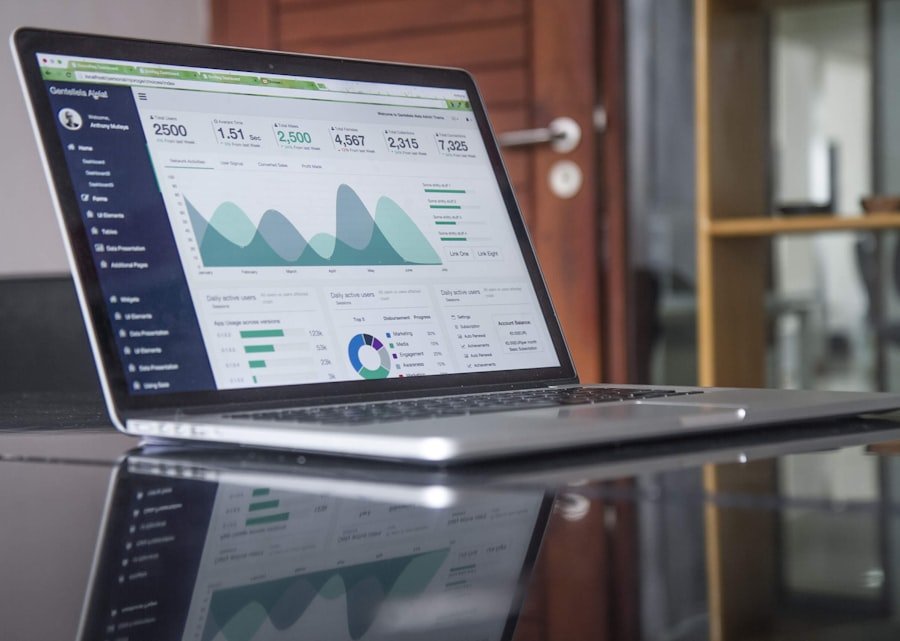The Software as a Service (SaaS) business model is a method of delivering software applications over the internet on a subscription basis. This model allows users to access the software from any device with an internet connection, without the need for expensive hardware or software installations. SaaS companies typically charge a monthly or annual fee for their services, providing a steady stream of recurring revenue.
This predictable revenue stream makes SaaS businesses attractive to investors and potential buyers. SaaS companies often have lower upfront costs compared to traditional software companies, as they do not need to produce physical copies of their software or distribute it through retail channels. Instead, they can focus on developing and improving their software, providing regular updates and customer support.
This flexibility allows SaaS companies to adapt to changing market demands and customer needs more quickly than traditional software companies. SaaS businesses also benefit from the ability to collect and analyze large amounts of data from their users, allowing them to make data-driven decisions and improve their products and services. This data can also be used to personalize the user experience and target marketing efforts more effectively.
Overall, the SaaS business model offers a scalable and flexible approach to delivering software services, making it an attractive option for both entrepreneurs and investors.
Key Takeaways
- SaaS business model relies on recurring subscription revenue and cloud-based software delivery
- Profitable SaaS websites have high customer retention, low churn rate, and strong market demand
- Financial health of a SaaS website can be evaluated through metrics like MRR, ARR, and CAC
- Technology and infrastructure assessment includes scalability, security, and integration capabilities
- User base and customer satisfaction can be analyzed through NPS, churn rate, and customer reviews
- Negotiating the purchase of a SaaS website should consider factors like IP ownership and transition support
- Scaling and growing a newly acquired SaaS website involves expanding the customer base, adding new features, and optimizing pricing models
Identifying Profitable SaaS Websites
Key Characteristics of Profitable SaaS Websites
Profitable SaaS websites typically have a strong customer base, high customer retention rates, and a proven track record of revenue growth. They offer a unique value proposition and address a specific market need or pain point, making them more likely to attract and retain customers, leading to sustainable revenue growth.
Scalability and Growth Potential
In addition to revenue growth, consider the scalability of the SaaS website. Look for websites that have the potential to expand their customer base and enter new markets. Scalable SaaS websites often have a strong product-market fit and a well-defined growth strategy. They may also have a competitive advantage, such as proprietary technology or unique features that set them apart from competitors.
Evaluating the Business Model
Finally, consider the overall health of the SaaS website’s business model. Evaluate the cost structure, profit margins, and cash flow to ensure that the website is financially sustainable. Profitable SaaS websites typically have a healthy balance between customer acquisition costs and customer lifetime value, allowing them to generate consistent profits over time.
Evaluating the Financial Health of a SaaS Website

When evaluating the financial health of a SaaS website, it’s important to consider key financial metrics that indicate the website’s profitability and sustainability. Start by analyzing the website’s revenue growth over time. Look for consistent revenue growth and a predictable revenue stream from subscription fees.
This indicates that the website has a strong customer base and is able to retain customers over the long term. Next, evaluate the website’s cost structure and profit margins. Look for websites with low variable costs and high gross margins, as this indicates that the website can generate profits efficiently as it scales.
Consider the website’s operating expenses, such as marketing and customer support costs, and assess whether these expenses are in line with industry standards and sustainable for the long term. Cash flow is another important indicator of a SaaS website’s financial health. Positive cash flow indicates that the website is able to generate more cash than it spends, allowing it to reinvest in growth opportunities or return value to shareholders.
Negative cash flow, on the other hand, may indicate that the website is not generating enough revenue to cover its expenses, leading to potential financial challenges in the future. Overall, evaluating the financial health of a SaaS website involves analyzing key financial metrics such as revenue growth, cost structure, profit margins, and cash flow. By understanding these metrics, you can make an informed investment decision and ensure that the website has the potential for long-term profitability and sustainability.
Assessing the Technology and Infrastructure
When assessing the technology and infrastructure of a SaaS website, it’s important to consider the website’s scalability, reliability, and security. Start by evaluating the website’s technology stack and infrastructure. Look for websites that use modern technologies and have a scalable architecture that can support growing user demand.
Consider whether the website has a reliable hosting provider and robust infrastructure that can handle high traffic volumes without downtime or performance issues. Security is another critical aspect of assessing a SaaS website’s technology and infrastructure. Look for websites that prioritize data security and have implemented industry best practices for protecting user data.
Consider whether the website has obtained relevant security certifications or undergone independent security audits to validate its security measures. In addition to scalability and security, consider the website’s technology roadmap and ongoing development efforts. Look for websites that invest in regular updates and improvements to their software, ensuring that they can adapt to changing market demands and user needs over time.
Consider whether the website has a dedicated technology team or access to external resources for ongoing development and maintenance. Overall, assessing the technology and infrastructure of a SaaS website involves evaluating its scalability, reliability, security, and ongoing development efforts. By understanding these aspects, you can ensure that the website has a solid foundation for long-term success and can support its growth ambitions effectively.
Analyzing the User Base and Customer Satisfaction
Analyzing the user base and customer satisfaction of a SaaS website is crucial for understanding its market position and growth potential. Start by evaluating the size and composition of the website’s user base. Look for websites with a diverse user base across different industries or geographic regions, indicating broad market appeal and potential for expansion.
Consider whether the website has a high customer retention rate, as this indicates strong customer satisfaction and loyalty. Next, assess customer satisfaction through user reviews, testimonials, or Net Promoter Score (NPS) surveys. Look for websites with positive feedback from users and high NPS scores, indicating that customers are satisfied with the website’s products and services.
Consider whether the website has a dedicated customer success team or support resources to ensure that customers have a positive experience using the website. In addition to customer satisfaction, consider whether the website has implemented user engagement strategies such as personalized onboarding experiences or targeted communication campaigns. Look for websites that prioritize user engagement and retention, as this indicates a proactive approach to building long-term customer relationships.
Overall, analyzing the user base and customer satisfaction of a SaaS website involves evaluating its market reach, customer retention rates, user feedback, and engagement strategies. By understanding these aspects, you can assess the website’s ability to attract and retain customers over the long term, driving sustainable revenue growth.
Negotiating the Purchase and Transitioning Process

Conducting Thorough Due Diligence
When negotiating the purchase of a SaaS website, it is essential to conduct thorough due diligence on the website’s financials, technology, customer base, and legal matters. This process helps you understand the website’s value proposition fully and identify potential risks and opportunities. By doing so, you can negotiate a fair valuation that reflects the website’s current performance and growth potential.
Payment Structure Options
The payment structure is a critical aspect of negotiating a SaaS website purchase. Consider different payment structures such as upfront payments, earn-outs based on future performance, or seller financing options. Evaluate which payment structure aligns with your investment goals and risk tolerance while providing fair compensation to the seller based on the website’s performance post-acquisition.
Transition Support and Post-Acquisition Planning
Transition support is another critical aspect of negotiating a SaaS website purchase. Consider whether the seller is willing to provide training, documentation, or ongoing support during the transition period to ensure a smooth handover of operations. Negotiate clear terms for transition support to minimize disruptions to customers or internal operations during the ownership transfer.
By conducting thorough due diligence, negotiating fair payment structures, and ensuring adequate transition support, you can ensure a successful acquisition process that aligns with your investment goals.
Scaling and Growing Your Newly Acquired SaaS Website
After acquiring a SaaS website, focus on scaling and growing its operations to maximize its potential value. Start by developing a growth strategy based on market research, customer feedback, and industry trends. Identify opportunities for expanding into new markets or adding new features to attract more customers and increase revenue streams.
Invest in marketing efforts to raise awareness of the website’s products or services among potential customers. Consider targeted advertising campaigns, content marketing initiatives, or partnerships with complementary businesses to reach new audiences effectively. In addition to marketing efforts, prioritize customer success initiatives to retain existing customers and drive word-of-mouth referrals.
Implement proactive customer support strategies, personalized onboarding experiences, or loyalty programs to build strong relationships with customers and encourage repeat business. Finally, consider strategic partnerships or acquisitions to accelerate growth opportunities for the newly acquired SaaS website. Look for complementary businesses or technologies that can enhance the website’s value proposition or expand its market reach effectively.
Overall, scaling and growing your newly acquired SaaS website involves developing a growth strategy, investing in marketing efforts, prioritizing customer success initiatives, and exploring strategic partnerships or acquisitions. By focusing on these areas, you can maximize the value of your investment and drive sustainable growth for the SaaS website over time.
If you’re looking to expand your online empire by purchasing a SaaS website, you may want to check out this article on Saas Marketplace titled “Hello World: A Beginner’s Guide to Buying a SaaS Website”. This article provides valuable insights and tips for those new to the SaaS marketplace, helping you make informed decisions when purchasing a SaaS website. It’s a great resource to complement the advice in “Create Your Online Empire: Tips for Buying a SaaS Website That Thrives.”
FAQs
What is a SaaS website?
A SaaS (Software as a Service) website is a platform that provides software applications to users over the internet, typically on a subscription basis. Users can access the software through a web browser without needing to install or maintain it on their own devices.
What are the benefits of buying a SaaS website?
Buying a SaaS website can provide several benefits, including a ready-made product with an existing customer base, recurring revenue from subscription fees, established infrastructure and technology, and the potential for scalability and growth.
What should I consider before buying a SaaS website?
Before buying a SaaS website, it’s important to consider factors such as the website’s financial performance, customer base and retention rates, technology stack and infrastructure, competition and market trends, and the potential for future development and growth.
How can I ensure that the SaaS website I buy will thrive?
To ensure that the SaaS website you buy will thrive, it’s important to conduct thorough due diligence, including financial and legal audits, technical assessments, and market analysis. Additionally, having a clear plan for post-acquisition integration, marketing, and product development can help set the website up for success.